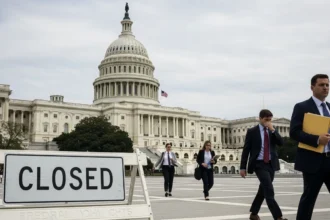Bitcoin is once again at the center of Wall Street’s attention. Major investment banks are forecasting ambitious price targets that suggest the world’s largest cryptocurrency could reach new highs before the end of 2025. JPMorgan models Bitcoin at $165,000, Citi sees a base case of $133,000 with a bullish scenario of $231,000, and Standard Chartered expects a move toward $200,000 by year-end.
The drivers behind these bold calls include record inflows into spot Bitcoin ETFs, the post-halving supply shock, and supportive macroeconomic policies.
Wall Street Price Targets, What the Banks Are Saying
JPMorgan, $165,000 Target
JPMorgan frames its forecast around Bitcoin’s relationship with gold, calling it a “debasement trade” as investors look for scarce assets in the face of fiat currency concerns. Based on its Bitcoin-to-gold ratio model, the bank projects an end-of-year target of around $165,000.
Citi, $133,000 Base Case, $231,000 Bull Case
Citi provides a range of scenarios rather than one figure. Its base case sits near $133,000, the bull case stretches as high as $231,000, and the bear case falls to around $82,000. This wide band reflects sensitivity to global macro conditions, the strength of the U.S. dollar, and gold’s performance.
Standard Chartered, $135,000 Short Term, $200,000 Year End
Standard Chartered has consistently taken a bullish stance on Bitcoin. The bank expects a short-term move to about $135,000, with a stronger push toward $200,000 by the close of 2025. Its outlook leans heavily on institutional adoption and accelerating ETF inflows.
Primary Drivers Behind the Forecasts
ETF Inflows: Big Money at Work
Spot Bitcoin ETFs have become a major catalyst in 2025. In just a few trading days, these funds attracted over $2.25 billion in net inflows, forcing direct Bitcoin purchases and tightening supply. Collectively, ETFs now hold between 1.3 and 1.47 million BTC, around 7 percent of the total supply, a concentration that significantly alters supply and demand dynamics.

Halving Supply Shock
The April halving reduced block rewards by 50 percent, cutting the pace of new Bitcoin entering circulation. With supply growth slowing and demand climbing, scarcity drives up the premium investors are willing to pay. Historically, every halving has preceded a multi-year bull cycle, although timing and magnitude vary.
Policy Catalysts and Fed Signals
Two policy shifts are worth noting. The U.S. government currently holds around 198,000 BTC, effectively treating it as part of a strategic reserve. At the same time, expectations of Federal Reserve rate cuts lower the opportunity cost of holding non-yielding assets like Bitcoin, making it more attractive as a hedge and alternative store of value.
Key Risks to Consider
Regulatory uncertainty. Sudden crackdowns, licensing delays, or restrictive legislation could cool momentum.
Market corrections. Historically, Bitcoin has suffered drawdowns of 50 percent or more, with worst-case cycles showing up to 80 percent declines.
Macro shocks. A hawkish Fed surprise, a strong dollar, or rising geopolitical tensions could trigger risk-off selling across crypto and equities.
Investment Takeaways
Retail Investors, Keep It Simple
For retail traders, dollar-cost averaging (DCA) remains one of the most practical approaches. It reduces timing risk and smooths volatility. Many analysts are watching the $116,000 to $117,000 range as a key technical support level. Retail investors should avoid overexposure, use proper stop-loss strategies, and steer clear of excessive leverage.
Bottom Line, A Realistic Roadmap
Wall Street forecasts suggest Bitcoin could realistically trade in a broad range, from $133,000 in conservative scenarios to $231,000 in bullish ones. The main cluster of institutional calls centers between $130,000 and $200,000.
If ETF inflows remain strong, halving-driven scarcity persists, and Fed policy turns supportive, higher price targets become achievable. On the other hand, regulatory setbacks or global instability could lead to sharp corrections.
For investors, the key is not chasing a single price target but creating a disciplined strategy. Treat Bitcoin as a volatile long-term asset, size positions carefully, and approach it with a plan rather than speculation.








